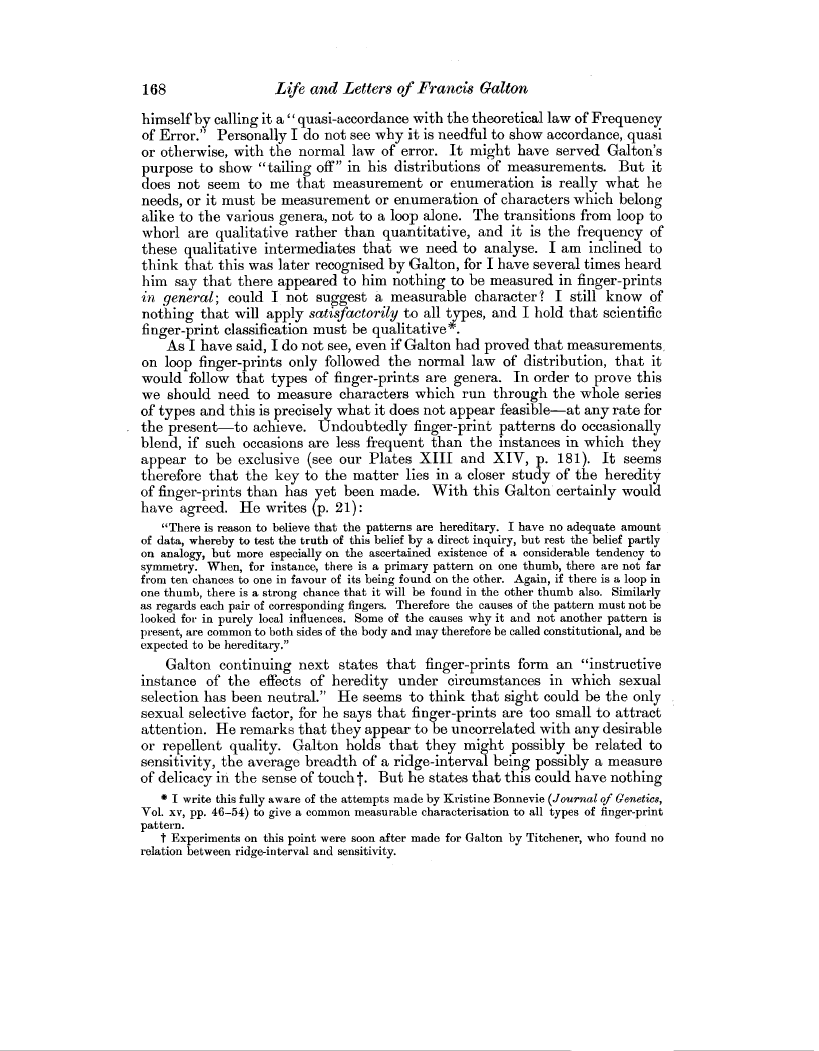| ||||||

OCR Rendition - approximate
168 Life and Letters of Francis Galton himself by calling it a " quasi-accordance with the theoretical law of Frequency of Error." Personally I do not see why it is needful to show accordance, quasi or otherwise, with the normal law of error. It might have served Galton's purpose to show "tailing off" in his distributions of measurements. But it does not seem to me that measurement or enumeration is really what he needs, or it must be measurement or enumeration of characters which belong alike to the various genera, not to a loop alone. The transitions from loop to whorl are qualitative rather than quantitative, and it is the frequency of these qualitative intermediates that we need to analyse. I am inclined to think that this was later recognised by Galton, for I have several times heard him say that there appeared to him nothing to be measured in finger-prints in general; could I not suggest a measurable character? I still know of nothing that will apply satisfactorily to all types, and I hold that scientific finger-print classification must be qualitative*. As I have said, I do not see, even if Galton had proved that measurements, on loop finger-prints only followed the normal law of distribution, that it would follow that types of finger-prints are genera. In order to prove this we should need to measure characters which run through the whole series of types and this is precisely what it does not appear feasible-at any rate for the present-to achieve. Undoubtedly finger-print patterns do occasionally blend, if such occasions are less frequent than the instances in which they appear to be exclusive (see our Plates XIII and XIV, p. 181). It seems therefore that the key to the matter lies in a closer study of the heredity of finger-prints than has yet been made. With this Galton certainly would have agreed. He writes (p. 21) "There is reason to believe that the patterns are hereditary. I have no adequate amount of data, whereby to test the truth of this belief by a direct inquiry, but rest the belief partly on analogy, but more especially on the ascertained existence of a considerable tendency to symmetry. When, for instance, there is a primary pattern on one thumb, there are not far from ten chances to one in favour of its being found on the other. Again, if there is a loop in one thumb, there is a strong chance that it will be found in the other thumb also. Similarly as regards each pair of corresponding fingers. Therefore the causes of the pattern must not be looked for in purely local influences. Some of the causes why it and not another pattern is present, are common to both sides of the body and may therefore be called constitutional, and be expected to be hereditary." Galton continuing next states that finger-prints form an "instructive instance of the effects of heredity under circumstances in which sexual selection has been neutral." He seems to think that sight could be the only sexual selective factor, for he says that finger-prints are too small to attract attention. He remarks that they appear to be uncorrelated with any desirable or repellent quality. Galton holds that they might possibly be related to sensitivity, the average breadth of a ridge-interval being possibly a measure of delicacy in the sense of touch'. But he states that this could have nothing * I write this fully aware of the attempts made by Kristine Bonnevie (Journal of Genetics, Vol. xv, pp. 46-54) to give a common measurable characterisation to all types of finger-print pattern. t Experiments on this point were soon after made for Galton by Titchener, who found no relation between ridge-interval and sensitivity.
|